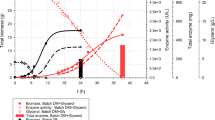Abstract
The production of recombinant Rhodobacter sphaeroides aminolevulinate (ALA) synthase was optimized in two strains of Escherichia coli: the wild-type strain MG1655, and a ptsG mutant AFP111. The effects of initial succinate, glucose and isopropyl-β-d-thiogalactopyranoside (IPTG) concentrations and the time of induction on enzyme activity were studied. One-way analysis was used to approximate the optimal ranges for these factors, followed by a full factorial design to quantify the effects of each factor and the interactions between the factors. Initial succinate, glucose, and IPTG concentration were observed to be the key factors affecting ALA synthase activity with the optimal levels determined to be above 6 g/l succinate, 0 g/l glucose, and 0.10 mM IPTG. ALA synthase activity was generally lower with AFP111 than with MG1655, and the effect of these three key factors was also lower with AFP111 than with MG1655. Based on the full factorial design results, a fermentation was completed that yielded 296 mU/mg protein with a final ALA concentration of 5.2 g/l (39 mM).





Similar content being viewed by others
References
Amann E, Ochs B, Abel KF (1988) Tightly regulated tac promoter vectors useful for the expression of unfused and fused proteins in Escherichia coli. Gene 69:301–315
Bunch PK, Mat-Jan F, Lee N, Clark DP (1997) The ldhA gene encoding the fermentative lactate dehydrogenase of Escherichia coli. Microbiology 143:187–195
Burnham BF (1970) δ-Aminolevulinic acid synthase. Methods Enzymol 17A:195–204
Chatterjee R, Millard CS, Champion K, Clark DP, Donnelly MI (2001) Mutation of the ptsG gene results in increased production of succinate in fermentation of glucose by Escherichia coli. Appl Environ Microbiol 67:148–154
Dean A, Voss D (1999) Design and analysis of experiments. Springer, New York Berlin Heidelberg, pp 561–564
Donnelly MI, Millard CS, Clark DP, Chen MJ, Rathke JW (1998) A novel fermentation pathway in an Escherichia coli mutant producing succinate acid, acetic acid, and ethanol. Appl Biochem Biotechnol 70–72:187–198
Donovan RS, Robinson CW, Glick BR (2000) Optimizing the expression of a monoclonal antibody fragment under the transcriptional control of the Escherichia coli lac promoter. Can J Microbiol 46:532–541
Eiteman MA, Chastain MJ (1997) Optimization of the ion-exchange analysis of organic acids from fermentation. Anal Chim Acta 338:69–70
Gibson J, Upper CD, Gunsalus IC (1967) Succinyl coenzyme A synthase from Escherichia coli. I. Purification and properties. J Biol Chem 242:2474–2477
Glick BR (1995) Metabolic load and heterologous gene expression. Biotechnol Adv 13:247–261
Guyer MS, Reed RE, Steitz T, Low KB (1981) Identification of a sex-factor-affinity site in E. coli as γδ. Cold Spring Harbor Symp Quant Biol 45:135–140
Haaland PD (1989) Experimental design in biotechnology. Statistics: textbooks and monographs, vol 105. Dekker, New York, p 201
Harrison JS, Keshavarz-Moore E, Dunnill P, Berry MJ, Fellinger A, Frenken L (1997) Factors affecting the fermentative production of a lysozyme-binding antibody fragment in Escherichia coli. Biotechnol Bioeng 53:611–622
Horn U, Strittmatter W, Krebber A, Knupfer U, Kujau M, Wenderoth R, Muller K, Matzku S, Pluckthun A, Riesenber D (1996) High volumetric yields of functional diametric miniantibodies in Escherichia coli, using an optimized expression vector and high-cell-density fermentation under non-limited growth conditions. Appl Microbiol Biotechnol 46:524–532
Jordan PM (1991) Biosynthesis of tetrapyrroles. New comprehensive biochemistry, vol 19. Elsevier, Amsterdam, pp 1–24
Klotsky RA, Schwartz I (1987) Measurement of cat expression from growth-rate-regulated promoters employing β-lactamase activity as an indicator of plasmid copy number. Gene 55:141–146
Kosinski MJ, Rinas U, Bailey JE (1992) Isopropyl-β-d-thiogalactopyranoside influences the metabolism of Escherichia coli. Appl Microbiol Biotechnol 36:782–783
Levy JG (1995) Photodynamic therapy. Trends Biotechnol 13:14–18
Li JM, Brathwaite O, Cosloy SD, Russel CS (1989) 5-Aminolevulinic acid synthesis in Escherichia coli. J Bacteriol 171:2547–2552
Malik Z, Hanania J, Nitzan Y (1990) New trends in photobiology: bactericidal effect of photoactivated porphyrins—an alternative approach to antimicrobial drugs. J Photochem Photobiol B Biol 5:281–293
March JC, Eiteman MA, Altman E (2002) Expression of an anaplerotic enzyme, pyruvate carboxylase, improves recombinant protein production in Escherichia coli. Appl Environ Microbiol 68:5620–5624
Neidle EL, Kaplan S (1993) Expression of the Rhodobacter sphaeroides hemA and hemT genes, encoding two 5-aminolevulinic acid synthase isozymes. J Bacteriol 175:2292–2303
Rebeiz CA, Montazer-Zouhoor A, Mayasich JM, Triphthy BC, Wu SM, Rebeiz CC (1988a) Photodynamic herbicides: recent development and molecular basis of selectivity. CRC Crit Rev Plant Sci 6:385–406
Rebeiz CA, Juvik JA, Rebeiz CC (1988b) Porphyric insecticides. 1. Concept and phenomenology. Pesticide Biochem Physiol 30:111–127
Reznikoff WS, Abelson JN (1980) The lac promoter. In: The operon. Cold Spring Harbor Laboratory. Cold Spring Harbor, N.Y., pp 221–224
Shibui T, Nagahari K (1992) Secretion of a functional Fab fragment in Escherichia coli and the influence of culture conditions. Appl Microbiol Biotechnol 37:352–357
Van der Werf MJ, Zeikus JG (1996) 5-Aminolevulinate production by Escherichia coli containing the Rhodobacter sphaeroides hemA gene. Appl Environ Microbiol 62:3560–3566
Vemuri GN, Eiteman MA, Altman E (2002) Effect of growth mode and pyruvate carboxylase on succinate acid production by metabolically engineered strains of Escherichia coli. Appl Environ Microbiol 68:1715–1727
Wlad H, Ballagi A, Bouakaz L, Gu Z, Janson JC (2001) Rapid two-step purification of a recombinant mouse Fab fragment expressed in Escherichia coli. Protein Expr Purif 22:325–329
Acknowledgements
The authors are grateful for the financial support from the Consortium for Plant Biotechnology Research, and for the technical assistance of Sarah Lee and Kris DeWitt. We thank Ellen Neidle for providing us with the pUI1015 plasmid.
Author information
Authors and Affiliations
Corresponding author
Rights and permissions
About this article
Cite this article
Xie, L., Hall, D., Eiteman, M.A. et al. Optimization of recombinant aminolevulinate synthase production in Escherichia coli using factorial design. Appl Microbiol Biotechnol 63, 267–273 (2003). https://doi.org/10.1007/s00253-003-1388-2
Received:
Revised:
Accepted:
Published:
Issue Date:
DOI: https://doi.org/10.1007/s00253-003-1388-2




